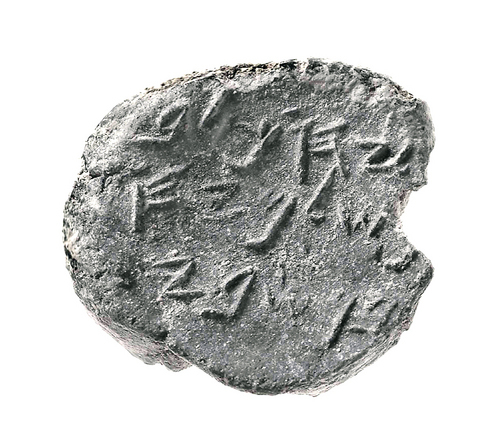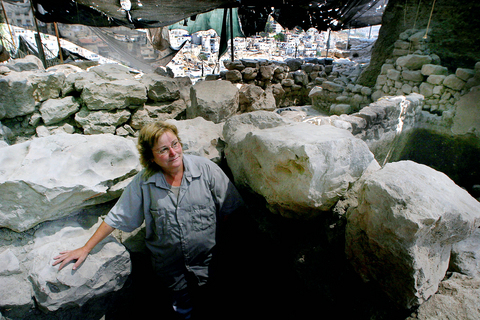An Israeli archaeologist says she has uncovered in East Jerusalem what may be the fabled palace of the biblical King David. Her work has been sponsored by a conservative Israeli research institute and financed by an American Jewish investment banker who would like to prove that Jerusalem was indeed the capital of the Jewish kingdom described in the Bible.
Other scholars are skeptical that the foundation walls discovered by the archaeologist, Eilat Mazar, are David's palace. But they acknowledge that what she has uncovered is rare and important: a major public building from around the 10th century BC, with pottery shards that date to the time of David and Solomon and a government seal of an official mentioned in the book of Jeremiah. The discovery is likely to be a new salvo in a major dispute in biblical archaeology: whether the kingdom of David and Samuel was of some historical magnitude, or whether the men were more like small tribal chieftains, reigning over another dusty hilltop.
The find will also be used in the broad political battle over Jerusalem -- whether the Jews have their origins here and thus have some special hold on the place, or whether, as many Palestinians have said, including the late Yasser Arafat, the idea of a Jewish origin in Jerusalem is a myth used to justify conquest and occupation. Hani Nur el-Din, a Palestinian professor of archaeology at Al Quds University, said he and his colleagues considered biblical archaeology an effort by Israelis "to fit historical evidence into a biblical context."

He added, "The link between the historical evidence and the biblical narration, written much later, is largely missing. There's a kind of fiction about the 10th century. They try to link whatever they find to the biblical narration. They have a button, and they want to make a suit out of it."
Even Israeli archaeologists are not so sure that Mazar has found the palace -- the house that Hiram, king of Tyre, built for the victorious king, at least as Samuel 2:5 describes it. It may also be the Fortress of Zion that David conquered from the Jebusites, who ruled Jerusalem before him, or some other structure about which the Bible is silent. Either way, they are impressed by its likely importance.
"This is a very significant discovery, given that Jerusalem as the capital of the united kingdom is very much unknown," said Gabriel Barkay, an archaeologist from Bar-Ilan University.

PHOTO: NY TIMES
"This is one of the first greetings we have from the Jerusalem of David and Solomon, a period which has played a kind of hide-and-seek with archaeologists for the last century."
Based on the Bible and a century of archaeology in this spot, Mazar, 48, speculated that a famous stepped-stone structure excavated previously was part of the fortress David conquered, and that his palace would have been built just outside the original walls of the cramped city, on the way to what his son, Solomon, built as the Temple Mount.
"When the Philistines came to fight, the Bible said that David went down from his house to the fortress," she said, her eyes bright. "I wondered, down from where? Presumably from where he lived, his palace."
"So I said, maybe there's something here," she added, referring to East Jerusalem. David's palace was the topic of a last conversation Mazar had with her grandfather, Benjamin Mazar, a famous archaeologist who helped to train her and who died 10 years ago. Five months ago, with money and permission from the Ir David Foundation, which controls the site (and supports Jews moving into East Jerusalem), she finally began to dig. Amihai Mazar, a professor of archaeology at Hebrew University, calls the find "something of a miracle."
He says he believes that the building may be the Fortress of Zion that David is said to have conquered, which he renamed the City of David.
"What she found is fascinating, whatever it is," he said. Amihai Mazar is Eilat Mazar's second cousin, but he has his own reputation to protect. Archaeologists debate "to what extent Jerusalem was an important city or even a city in the time of David and Samuel," he said.
"Some believe it was tiny and the kingdom unimportant."
The site of ancient Jerusalem, stuck between two valleys on a ridge south of the Temple Mount, is very small, less than 10 acres. Israel Finkelstein, another renowned archaeologist, has suggested that without significant evidence, Jerusalem in this period was "perhaps not more than a typical hill-country village."
In his book, The Bible Unearthed, Finkelstein writes with Neil Silberman, "Not only was any sign of monumental architecture missing, but so were even simple pottery shards."
The building can be reasonably dated by the pottery found above and below it. Mazar found on the bedrock a large floor of crushed limestone, indicating a large public space. The floor and fill above it contain pottery from Iron Age I of the 12th to 11th centuries BC, just before David conquered Jerusalem. Above that, Mazar found the foundations for this monumental building, with large boulders for walls that are more than 1.8m thick and extend at least 30m. In one corner was pottery from Iron Age 2, the 10th to 9th centuries, roughly the time of the united kingdom. Unfortunately, Amihai Mazar said, she found no floor. It is clear the building was constructed after the pottery underneath it, but less clear exactly how much later.
The archaeological debate is also partly a debate over the roots of Zionism and the effort to find Jewish origins deep in the land. Eilat Mazar's latest dig, which has cost about US$500,000, has been sponsored by Roger Hertog, a New York financier who is vice chairman of Alliance Capital Management. Hertog, who owns a piece of The New York Sun and The New Republic, is also chairman of the board of the Shalem Center in Jerusalem, where Mazar is a senior fellow.
The Shalem Center was founded as Israel's first "neoconservative think-tank," said William Kristol, who is also on the board, in an effort to give the Israeli right a better foundation in history, economics, archaeology and other topics. Hertog calls his investment in Mazar "venture philanthropy -- you have the opportunity for intellectual speculation, to fund something that is a work of great consequence." He said he hoped to show "that the Bible reflects Jewish history."
Mazar continues to dig, but right now, three families are living in houses where she would most like to explore. One family is Muslim, one Christian and one Jewish.

Exceptions to the rule are sometimes revealing. For a brief few years, there was an emerging ideological split between the Democratic Progressive Party (DPP) and Chinese Nationalist Party (KMT) that appeared to be pushing the DPP in a direction that would be considered more liberal, and the KMT more conservative. In the previous column, “The KMT-DPP’s bureaucrat-led developmental state” (Dec. 11, page 12), we examined how Taiwan’s democratic system developed, and how both the two main parties largely accepted a similar consensus on how Taiwan should be run domestically and did not split along the left-right lines more familiar in

This month the government ordered a one-year block of Xiaohongshu (小紅書) or Rednote, a Chinese social media platform with more than 3 million users in Taiwan. The government pointed to widespread fraud activity on the platform, along with cybersecurity failures. Officials said that they had reached out to the company and asked it to change. However, they received no response. The pro-China parties, the Chinese Nationalist Party (KMT) and Taiwan People’s Party (TPP), immediately swung into action, denouncing the ban as an attack on free speech. This “free speech” claim was then echoed by the People’s Republic of China (PRC),

As I finally slid into the warm embrace of the hot, clifftop pool, it was a serene moment of reflection. The sound of the river reflected off the cave walls, the white of our camping lights reflected off the dark, shimmering surface of the water, and I reflected on how fortunate I was to be here. After all, the beautiful walk through narrow canyons that had brought us here had been inaccessible for five years — and will be again soon. The day had started at the Huisun Forest Area (惠蓀林場), at the end of Nantou County Route 80, north and east

Specialty sandwiches loaded with the contents of an entire charcuterie board, overflowing with sauces, creams and all manner of creative add-ons, is perhaps one of the biggest global food trends of this year. From London to New York, lines form down the block for mortadella, burrata, pistachio and more stuffed between slices of fresh sourdough, rye or focaccia. To try the trend in Taipei, Munchies Mafia is for sure the spot — could this be the best sandwich in town? Carlos from Spain and Sergio from Mexico opened this spot just seven months ago. The two met working in the